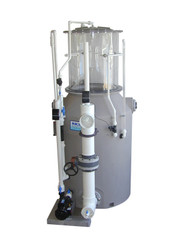What is Protein Skimming?
Posted by By Ken S. Feldman, Kelly M. Maers, Lauren F. Vernese, Elizabeth A. Huber, Matthew R. Test on 11th Jan 2019
Water purification through skimming has been thoroughly reviewed in the aquarium literature (Holmes-Farley, 2006) and so the description of the basics will be brief. In essence, skimming involves introducing air bubbles into aquarium water, and then physically removing those bubbles after they have absorbed organic impurities. The mechanisms by which the bubbles are introduced, how they are mixed with the water, and how they are removed from the bubble/water mixture can be addressed by distinctly different engineering approaches, and these differences presumably constitute the basis for claims of "better" (or at least different) amongst the various skimmer manufacturers. The bubbles themselves are the key, as they provide an air-water interface that is particularly favorable for adsorption of certain kinds of organic molecules. Not all organic molecules are susceptible to this type of capture; in fact, only those molecules that have distinct hydrophilic (= water loving) and hydrophobic (= water hating) sub-regions attach tightly to this surface. The hydrophilic portion of the molecule remains in the water, but the hydrophobic portion is forced out of the water and into the air space of the bubble. The process is illustrated for the generic skimmer pictured in Fig. 1. This skimmer is fed aquarium water via a pump, and that water is mixed vigorously with small air bubbles at the inlet. These bubbles pass through the water in the skimmer body and absorb susceptible organic molecules as they transit up the column. The water in the skimmer body then exits back to the aquarium, less the removed organics. The bubbles, on the other hand, coalesce into a foam at the top of the water column, and their continuous replenishment at the bottom of the foam forces the top of the foam out over a riser tube and into a collection annulus. This foam carries with it an organic load, and physical removal of this organic-rich foam/residue/sludge completes the water purification process. In addition to some dissolved organics, small particulates and microbes (bacterioplankton, phytoplankton) can be removed at the air/water interface of the bubble as well (Suzuki, 2008). The skimming process does not remove atoms/molecules that are strictly polar and readily dissolve in water, such as some organics, salts, inorganic phosphate, carbonate, etc.

